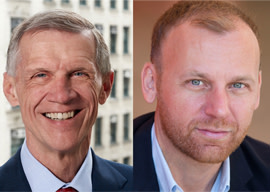
The Chronicle of Higher Education recently published an article called, “Can Design Thinking Redesign Higher Ed?” As we're in the design thinking business, and as higher education is a focus of ours, we were excited. And then we read it—and saw that the piece, while well-written and reported, didn't speak directly to administrators. Someone needed to do so. And now someone has…
The perfect provost juggles live chainsaws and greased watermelons. Today’s administrator must be all these things: inspiring educator, pragmatic COO, and subtle diplomat among passionate experts. A weaver of a harmonious social fabric, and simultaneously a patient untier of knots. Visionary, yet a master of incrementalism. But nobody is perfect.
A successful administrator is a person of great interpersonal talents who also happens to be in an occasionally impossible job.
Higher education is going through tectonic changes. Students’ needs are changing, while existing business models are reaching the limits of their growth potential, and technology is enabling radical alternatives. The fundamental value proposition of a four-year residential college is being questioned by “customers” and eroded by other options. The need to find new ways to thrive, or reinvigorate beloved old ones, is growing acute.
Necessity, may I introduce you to Invention. The term “design thinking” refers to ways of being inventive and proactive about the future. It encompasses a cultivated mindset and structured process for tackling all sorts of challenges, broadly applicable outside the traditional esthetic domain of design. Design entails the ingenious framing of problems and elegant crafting of their solutions. Design thinking is particularly effective in this kind of environment: complex systems with messy stakeholder ecology, constrained by bureaucracy or regulation, threatened by disruptive business models, unaccustomed to thinking in terms of the design of someone’s experience.
A successful administrator is a person of great interpersonal talents who also happens to be in an occasionally impossible job.
I propose that there are three ways that design thinking can make your job easier: by helping you get unstuck on the most intractable of problems, by synthesizing perspectives to build a shared model of the goal, and by modeling a safe, progressive process for building and testing ideas.
Reframing Intractable Problems
The decision-making process in higher education can be politically intricate and procedurally opaque. In this environment, even a great idea must be socialized in the right way or it will be rejected. The insistence on right process can lead to locked-in orthodoxies, or lower expectations about what is possible. This leads to teams utterly unprepared to take on unfamiliar challenges. They are stuck at the outset, asked to confront problems that everybody agrees are essential to address, but nobody believes are possible to resolve.
There are many kinds of intractable problem. Most commonly, they are zero-sum, or circular (chicken and egg), or everybody’s-yet-nobody’s problems. Intractable challenges require the jolt of a fundamental re-frame. And reframing problems is a core promise of design thinking.
One of the best ways to break your existing paradigm is to get people to articulate and agree on what is desired as an experience. With this reframe, the focus is not the thing, not on what you are making or offering; it’s on what happens to people as a result. What’s the desired impact on a student’s life and learning? Thinking this way is a big shift. Reframing, especially around experience, helps us get diverse and even combative groups all looking at the same problem in compatible ways.
Synthesizing Diverse and Passionately Held Viewpoints
Design thinking projects often require that we bring together the diverse perspectives of passionate experts. Building consensus in a fiercely independent stakeholder ecosystem is a crucial prerequisite.
No change can be imposed on people as independent as members of a university faculty. Any progress must be activated by self-interest, and grounded in intrinsic motivation and belief.
Higher education is a highly political and territorial environment, one where expertise is highly valued. We recognize that we are never going to be experts in our clients’ business. Designers have complementary skills in synthesis. We become facilitators and mediators in environments where very diverse constituencies have very different needs. This was certainly the case when we helped Boston College redesign its core curriculum.
When we design for experience our aims center on how people feel and behave, and we know you can’t force it. No change can be imposed on people as independent as members of a university faculty. Any progress must be activated by self-interest, and grounded in intrinsic motivation and belief.
Making Progress Possible
There is a very deliberate process for how we move through projects, which is especially valuable for projects with uncertain or open outcomes. Generally, we move through a succession of four questions with a sense of momentum that feels almost inevitable. We go from asking “What do we know?” to “What does it mean?” to “What should we do?”—that is, the strategy—to “What does that look and feel like?” Finally, we design and test in fast iterations to make sure it works.
At the end of each phase, we build consensus around our current decisions and capture the implications that frame and drive the next phase. Each phase has a rhythm of divergent thinking, where we ensure everyone is appropriately heard and engaged, and convergent thinking, where we drive toward decisions and consensus. This way of working can look unstructured, but it is extremely rigorous and evidence based.
Our universities are not good at acting with urgency, or asking for help. We understand why people ignore the hardest problems.
Start Here
What to do first? First steps should be the minimum viable experience, as a testable hypothesis. The criteria and measures for first steps are different. Initial actions should also: (1) Signal change with as much symbolic and storytelling value as possible (2) Facilitate subsequent steps, by addressing dependencies and filling prerequisites; and (3) Prioritize learning and risk mitigation.
Our universities are not good at acting with urgency, or asking for help. We understand why people ignore the hardest problems. We often have the job of demonstrating the need for and possibility of action. Design thinking offers a powerful way to confront complexity and uncertainty.
The promise of a great education, especially one in the liberal arts, is that it doesn’t just teach you facts and ideas, but durable, resilient ways to confront any new question. By that standard, design may be the paragon of the liberal arts.




